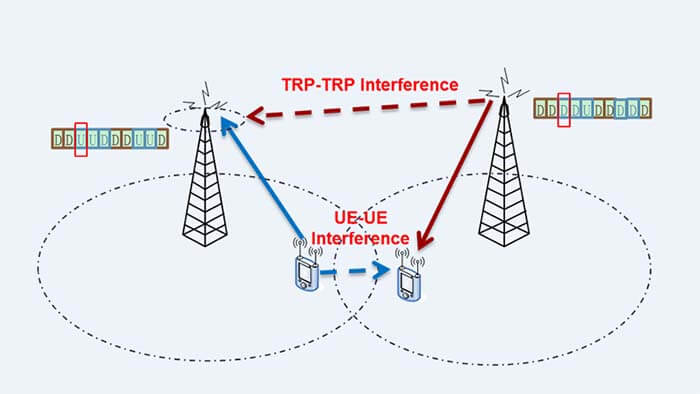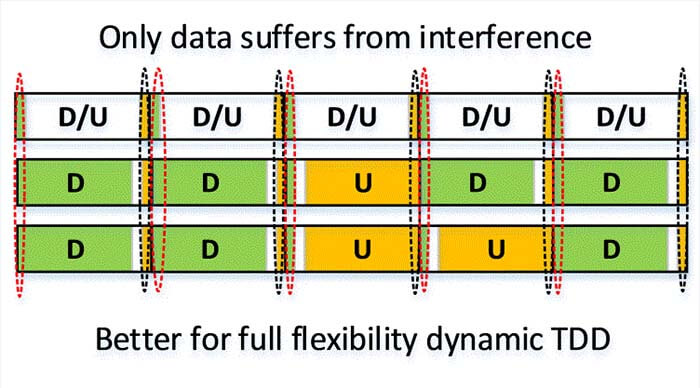What is the purpose of 5G flexible duplexing?
The purpose of 5G flexible duplexing is to allow the most flexible use of an operator’s spectrum for time-frequency resources in a single framework. 5G Flexible duplexing should inherently support both paired and unpaired spectrum and be forward compatible with full-duplex 5G.
For 5G flexible duplexing in the unpaired spectrum (i.e., dynamic TDD), most of the time-frequency resources can be flexibly allocated to uplink and downlink based on instantaneous uplink and downlink service changes.
For 5G flexible duplexing in the paired spectrum, it refers to the usage in which downlink and uplink transmissions can occur in each portion of the paired spectrum.
For 5G flexible duplexing of paired spectrum, note that the division of uplink and downlink time resources in each part of the paired spectrum can be semi-static or dynamic.
5G Flexible duplexing is intended to allow the most flexible use of the time-frequency resources of the operator’s spectrum in a single framework. The time-frequency resources can be flexibly allocated to all transmission directions (downlink, uplink, side link, and backhaul link) to accommodate a variety of use cases, deployment scenarios, service loads, and asymmetries.
Operators should also comply with regional regulatory requirements when deciding how to use their spectrum resources. Note that 5G flexible duplexing also provides convergence of FDD and TDD in NR. With flexible resource allocation, cross-link interference is one of the key issues that need to be addressed.
Fo 5G flexible duplexing on the unpaired spectrum (i.e., dynamic TDD), the transmission direction of most of the time resources can be adjusted according to instantaneous traffic changes, which facilitates improved user-perceived packet throughput and user experience. a similar feature, eIMTA, is introduced in LTE Rel-12.
However, the design of LTE eIMTA is not fully optimized in terms of performance due to backward compatibility limitations. In addition, since no interference cancellation mechanism is specified in LTE-eIMTA, LTE-eIMTA’s upstream and downstream flexible subframe assignment is limited to isolated cells or cell clusters.
Given the absence of backward compatibility constraints, NR has the potential to take full advantage of the benefits of flexible resource allocation. In addition to flexible resource allocation on the unpaired spectrum, semi-static temporal resource division between upstream and downstream is also necessary.
5G flexible duplexing on paired spectrum allows upstream and downstream transmissions in either part of the paired spectrum, which can achieve better spectrum utilization in scenarios where downlink services dominate. Several operations can be envisaged.
- One part of the paired spectrum is used mainly for downlink transmissions, while the other part of the paired spectrum is used for both upstream and downstream transmissions. The allocation of time resources for uplink and downlink on the latter part of the paired spectrum can be dynamic or semi-statistical.
- In the downlink main part of the paired spectrum, an uplink probe reference signal is sent to exploit channel reciprocity and thus better support massive MIMO.
Depending on the operator’s choice, the two use cases of 5G flexible duplexing in the paired spectrum can be deployed individually or jointly.
With flexible time-frequency allocation, different types of links, such as access/backhaul/sidechain, can be supported in the NR in an integrated manner in the same cell or in the same TRP.
Time intervals can be dynamically allocated for access, backhaul, and sidechain. Multiple links can also be supported in the same time interval, e.g. through frequency domain multiplexing or air domain multiplexing.
From the physical layer perspective, it is beneficial to support a unified frame structure in order to achieve single frame operation for duplexing in NR, i.e., 5G flexible duplexing. Unlike LTE, which defines frame structures for FDD and TDD separately, NR can have a single frame structure, which allows the design goal of 5G flexible duplexing to be achieved. The unified frame structure design can consider the following points.
- A number of subframe types are defined, such as DL-only subframe, UL-only subframe, and mixed DL/UL subframe. These subframe types are the building blocks of the unified frame structure.
- A wireless frame of a certain duration is defined, which consists of several subframes.
- The subframe type of each subframe in the wireless frame is configured by the network through L1 signaling or RRC signaling. Note that for DL use, some time frequencies may be fixed, for example, for DL synchronization signals, RS for RRM measurements, and MIB transmissions.
With the unified frame structure described above, the operator has the flexibility to assign the transmission direction of each subframe. Note that the unified frame structure is independent of the carrier frequencies of the DL and UL transmissions.
The network determines the DL and UL carrier frequencies. For the UE, the DL carrier frequency is obtained by DL synchronization signal detection and the UL carrier frequency can be derived from the system information.
The unified frame structure is forward compatible for full-duplex 5G if the DL and UL carrier frequencies are the same and DL transmission and UL reception overlap in time at the node.
For 5G flexible duplexing on the paired and unpaired spectrum, cross-link interference, such as TRP-to-TRP and UE-to-UE interference, exists when different transmission directions are used on the same time-frequency resource in neighboring cells.
An example of cross-link interference is shown in Figure 1. The uplink-downlink assignment illustration can be on an unpaired spectrum or on a part of the paired spectrum.

Figure 1: Cross-link interference
Mitigation of cross-link interference was also investigated during the LTE eIMTA work. Typically, cross-link interference can be mitigated using a combination of standardized solutions and implementation-dependent solutions.
For NR, compared to the cross-link interference evaluated in LTE-eIMTA, cross-link interference may exhibit different behavior.
- The new carrier frequency range is specific to NR compared to LTE.
Larger path loss in higher frequency bands reduces cross-link interference compared to what is observed in LTE eIMTA.
- Massive MIMO is an effective tool to combat cross-link interference and improve system performance.
The statistical information of cross-link interference changes in the case of large-scale MIMO with very narrow beamwidth and beamforming compared to that observed in LTE-eIMTA.
Cross-link interference mitigation schemes help to extend the possible deployment scenarios where 5G flexible duplexing can be applied and therefore deserve careful study and evaluation of NR for paired and unpaired spectrum.
A variety of CIM schemes can be considered, including coordinated beam assignment or beam zeroing, symmetric design, interference alignment, power control, interference sensing, and measurement, and resource unit-specific reference signals.
Note that these cross-link interference mitigation schemes can typically be applied to both unpaired and paired spectra.
For a given physical channel, note that cross-link interference may exist not only for the data channel but also for the control channel.
Cross-link interference on the control channel can be avoided by proper design of subframe/time slot types and HARQ/scheduling timing.
For example, mixing DL/UL subframes/timeslots can provide the possibility to align the control channel across cells as shown in Figure 2, which minimizes the impact of cross-link interference on the control channel.
It should be noted that it is not required that all subframes are mixed DL/UL subframes/timeslots. As long as the time resources of the control channel can be coordinated between adjacent cells, there may be no cross-link interference on the control channel.

Figure 2: Mixed DL/UL subframes/timeslots to avoid cross-link interference on the control channel
If the semi-static operation is used on the paired and unpaired spectrum, cross-link interference may not exist if adjacent cells use the same allocation of upstream and downstream subframes. This is similar to traditional TDD operation where the uplink and downlink configurations are common to all cells.
To make better use of flexible resources on the paired and unpaired spectrum, NR should support mechanisms to maximize the resources available for flexible use.
For 5G flexible duplexing, fixed DL resources are still needed to transmit basic signals such as MIB, synchronization signals, or some reference signals.
Typically, the fixed DL resources may occupy some subframes or some time slots, or some OFDM symbols. The occupied resources should be minimized to leave as many resources as possible for flexible use.
For the non-independent case, the UE may obtain system information from other carriers, which allows a further reduction of the fixed resources. For the stand-alone case, an appropriate channelization design should be used to reduce the occupied fixed resources.
To take advantage of a fully dynamic indication of the transmission direction of each flexible resource, the signaling design needs to enable dynamic resource allocation on a time slot/subframe basis. Either implicit or explicit signaling designs are possible and need further investigation.
Note that this dynamic indication of resource allocation between different links is common for both unpaired and paired spectrums.
For both paired and unpaired spectra, dynamic signaling for flexible resource indication is not needed if semi-static resource partitioning is applied (i.e., the upstream and downstream configurations are semi-statically indicated).
This semi-static resource partitioning can be predefined or indicated by RRC signaling for unpaired and paired spectra.
Flexible HARQ/scheduling timing is considered beneficial for NR. it has been agreed to explicitly indicate the HARQ timing between the data transmission and the corresponding A/N.
In addition, it has been agreed that the scheduling timing between UL authorization and UL data is also explicitly indicated. It is also beneficial to allow explicit and flexible indications of scheduling timing between DL authorization and DL data. HARQ/scheduling timing should be designed to effectively support 5G flexible duplexing.
In particular, for flexible duplexing, it should allow HARQ-ACK transmissions corresponding to DL data in a subset of subframes/timeslots.
This is due to the fact that much fewer subframes/time slots are allocated for UL than for DL, in order to accommodate the DL-heavy services observed in real networks.
In LTE, each band definition is associated with a predefined duplex mode (i.e. FDD, TDD, or SDL). Therefore, in order to provide the most flexible spectrum usage for operators, it is expected that the NR band is not associated with any specific duplex mode.
The NR band should simply define whether it is paired spectrum or an unpaired spectrum and its corresponding frequency range. It is then up to the operator to decide how to use the spectrum, provided that regional regulatory requirements are adhered to.
Besides the What is 5G Flexible Duplexing article, you may also be interested in the below articles.
4G vs 5G: What is the difference between 4G and 5G?
How to Choose the Best Antenna for Lora?
